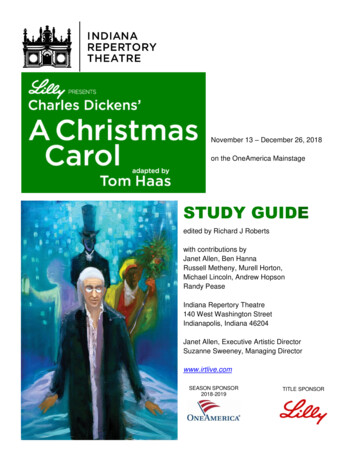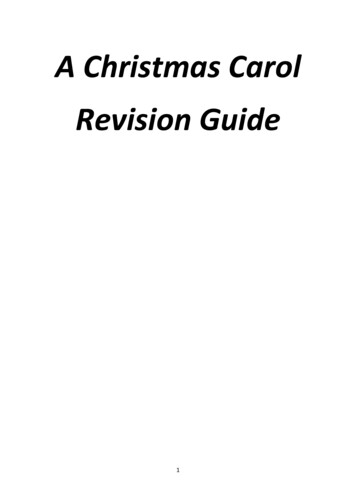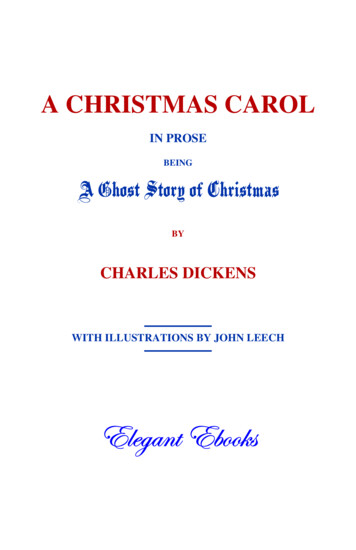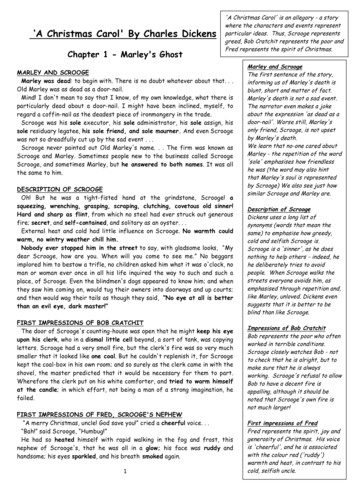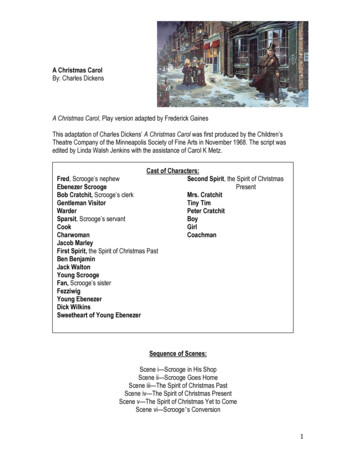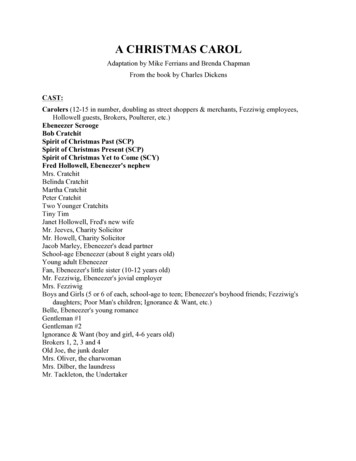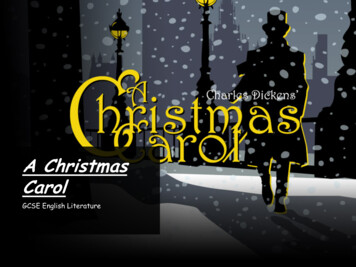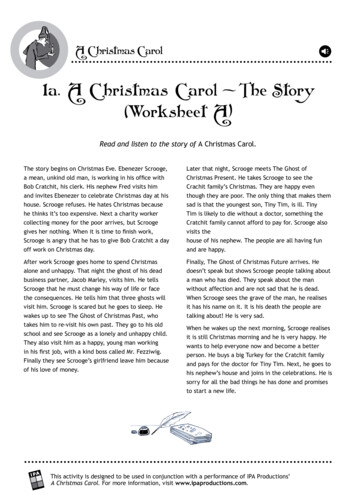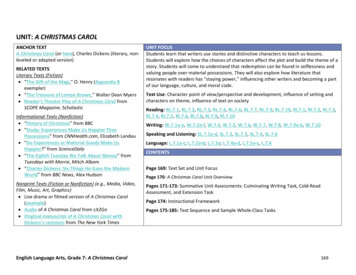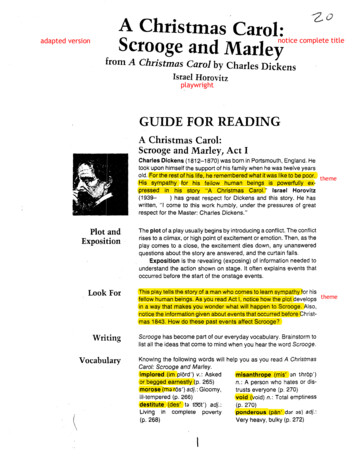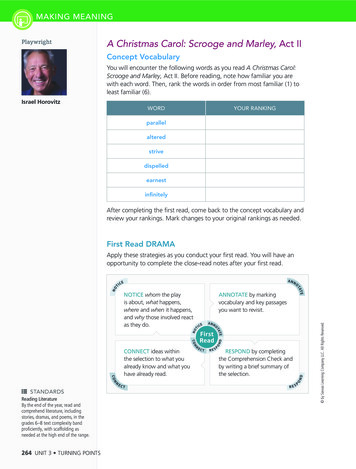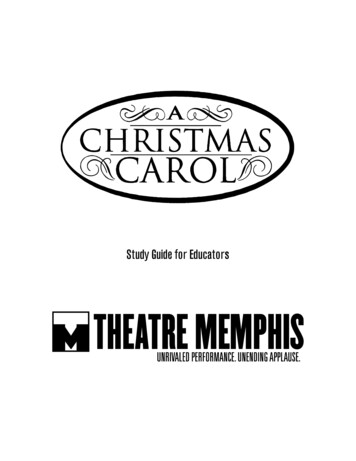
Transcription
Study Guide for Educators
Theatre MemphisPresents:Charles D ickens’A Ch r is t mA s C A r o lAbout ShoWagon:Having started as an outreach program more than 30 years ago by Theatre Memphis,ShoWagon is a children’s theatre company made up of professional actors. These actorsare dedicated to bringing classic works of literature to life while providing a knowledgeand experience base for educators to draw from. It is the goal of ShoWagon’s members todeepen and broaden each student’s understanding of literary and dramatic works of artand to inspire confidence in their own abilities to articulate their perspectives of theworld. In the past, ShoWagon has performed MacBeth, Tom Sawyer, Twelfth Night, TheCrucible, Rikki-Tikki-Tavi, Aesop’s Fables, American Heroes of Tall Tales, Alice inWonderland, Little House, and A Christmas Carol.About the Artists:Jason Spitzer, (Director,Playwright)A very talented local director and actor, Jason has helmed such productions as Beauty and theBeast, South Pacific, Forbidden Broadway, and Gorey Stories, while appearing in productions ofCats, Bus Stop, Dracula, The Violet Hour, and The King and I. Mr. Spitzer holds a bachelor’sdegree in English and a master’s degree in education.Christopher McCollum (Resident Scenic Designer) Before joining Theatre Memphis he hasspent over 20 years working as a freelance Set and Costume designer. His work has been seenthroughout the country, including designs for Houston Grand Opera’s LITTLE WOMEN, seen onPBS. In 2010 he received the Individual Artists Grant for excellence in Theatre Design from theTennessee Arts Commission. He is also a graduate of Carnegie-Mellon University and a memberof United Scenic Artists, Local 829.2
2014 Christmas Carol Cast & CrewEbenezer ScroogeBob CratchitFredCharity Collector OneCharity Collector TwoMrs. DilberMarley's GhostGhost of Christmas PastEbbyRon GordonDoug JohnsonZack WilliamsJames CacyBryce JacksonTaylor WoodRob AymettLena WallaceEthan WittCobbeyGraymarshMobbsSchoolmasterFanMr. FezziwigDavis JacksonClayton JacksonSamuel NuttZack WilliamsKiah JacksonJerry WakefieldYoung ScroogeBelleJacob MarleyThe Ghost of Christmas PresentMrs. CratchitMartha CratchitPeter CratchitBelinda CratchitAnnie CratchitTiny TimMillieTopperLucyFred's DaughterOld JoeWantIgnoranceGhost of Christmas Yet to ComeTurkey BoyCoachmanBeggarDoug JohnsonTaylor WoodRob AymettJames CacyLena WallaceKiah JacksonDavis JacksonLilly NuttBethany PatrickEthan WittTaylor WoodKarl GuentherAlexis BarganierLydia NuttRob AymettBethany PatrickJacey JacksonKarl GuentherChristina HendricksKarl GuentherAlexis BarganierDirectorMusic DirectorScenic & Properties DesignerCostume DesignerSound DesignerLight DesignerStage ManagerAssistant Stage ManagerJason SpitzerJeff BrewerJack YatesPaul McCraeJohn HiltonsmithJeremy FisherMelissa Andrews & Amy Salerno HaleSusan Strickland3
The AuthorAn extensive BiographyDICKENS, CHARLES JOHN HUFFAM (1812—1870),LifeEarly years2 Ordnance Terrace, Chatham, Dickens's home 1817–1822Charles Dickens was born at Landport, in Portsea, on February 7, 1812, to John andElizabeth Dickens. He was the second of their eight children. His father was a clerk in theNavy Pay-office, and was temporarily on duty in the neighborhood. Very soon after thebirth of Charles Dickens, however, the family moved for a short period to Norfolk Street,Bloomsbury, and then for a long period to Chatham, in Kent, which thus became the realhome, and for all serious purposes, the native place of Dickens. His early years seem tohave been idyllic, although he thought himself a "very small and not-over-particularlytaken-care-of boy". He spent time outdoors, but also read voraciously, especially thepicaresque novels of Tobias Smollett and Henry Fielding. He spoke, later in life, of hispoignant memories of childhood, and of his near-photographic memory of the people andevents, which he used in his writing. His father's brief period as a clerk in the Navy PayOffice afforded Charles a few years of private education at William Giles's School, inChatham.This period came to an abrupt end when the Dickens family, because of financialdifficulties, moved from Kent to Camden Town, in London in 1822. John Dickens,continually living beyond his means, was eventually imprisoned in the Marshalseadebtor's prison in Southwark, London in 1824. Shortly afterwards, the rest of his familyjoined him – except 12-year-old Charles, who boarded with family friend ElizabethRoylance in Camden Town. Mrs. Roylance was "a reduced old lady, long known to ourfamily", whom Dickens later immortalized, "with a few alterations and embellishments",as "Mrs. Pipchin", in Dombey and Son. Later, he lived in a "back-attic.at the house of an4
insolvent-court agent.in Lant Street in The Borough.he was a fat, good-natured, kindold gentleman, with a quiet old wife"; and he had a very innocent grown-up son; thesethree were the inspiration for the Garland family in The Old Curiosity Shop.The Marshalsea around 1897, after it had closedOn Sundays, Dickens and his sister Frances ("Fanny") were allowed out from the RoyalAcademy of Music and spent the day at the Marshalsea (Dickens later used the prison asa setting in Little Dorrit). To pay for his board and to help his family, Dickens was forcedto leave school and began working ten-hour days at Warren's Blacking Warehouse, onHungerford Stairs, near the present Charing Cross railway station. He earned six shillingsa week pasting labels on blacking. The strenuous – and often cruel – work conditionsmade a deep impression on Dickens, and later influenced his fiction and essays, formingthe foundation of his interest in the reform of socio-economic and labor conditions, therigors of which he believed were unfairly borne by the poor. He would later write that hewondered "how I could have been so easily cast away at such an age." As told to JohnForster (from The Life of Charles Dickens):5
A 1904 artist's impression of Dickens in the blacking factory“The blacking-warehouse was the last house on the left-hand side of the way,at old Hungerford Stairs. It was a crazy, tumble-down old house, abutting ofcourse on the river, and literally overrun with rats. Its wainscoted rooms, andits rotten floors and staircase, and the old grey rats swarming down in thecellars, and the sound of their squeaking and scuffling coming up the stairs atall times, and the dirt and decay of the place, rise up visibly before me, as if Iwere there again. The counting-house was on the first floor, looking over thecoal-barges and the river. There was a recess in it, in which I was to sit andwork. My work was to cover the pots of paste-blacking; first with a piece ofoil-paper, and then with a piece of blue paper; to tie them round with a string;and then to clip the paper close and neat, all round, until it looked as smart asa pot of ointment from an apothecary's shop. When a certain number ofgrosses of pots had attained this pitch of perfection, I was to paste on each aprinted label, and then go on again with more pots. Two or three other boyswere kept at similar duty down-stairs on similar wages. One of them came up,in a ragged apron and a paper cap, on the first Monday morning, to show methe trick of using the string and tying the knot. His name was Bob Fagin; andI took the liberty of using his name, long afterwards, in Oliver Twist.”After only a few months in Marshalsea, John Dickens' paternal grandmother, ElizabethDickens, died and bequeathed him the sum of 450. On the expectation of this legacy,Dickens was granted release from prison. Under the Insolvent Debtors Act, Dickensarranged for payment of his creditors, and he and his family left Marshalsea for the homeof Mrs. Roylance.Although Charles eventually attended the Wellington House Academy in North London,his mother Elizabeth Dickens did not immediately remove him from the boot-blackingfactory. The incident may have done much to confirm Dickens's view that a father shouldrule the family, a mother find her proper sphere inside the home. "I never afterwardsforgot, I never shall forget, I never can forget, that my mother was warm for my beingsent back." His mother's failure to request his return was no doubt a factor in hisdissatisfaction towards women.6
Righteous anger stemming from his own situation and the conditions under whichworking-class people lived became major themes of his works, and it was this unhappyperiod in his youth to which he alluded in his favorite, and most autobiographical, novel,David Copperfield: "I had no advice, no counsel, no encouragement, no consolation, noassistance, no support, of any kind, from anyone, that I can call to mind, as I hope to goto heaven!" The Wellington House Academy was not a good school. 'Much of thehaphazard, desultory teaching, poor discipline punctuated by the headmaster's sadisticbrutality, the seedy ushers and general run-down atmosphere, are embodied in Mr.Creakle's Establishment in David Copperfield. Dickens worked at the law office of Ellisand Blackmore, attorneys, of Holborn Court, Gray's Inn, as a junior clerk from May 1827to November 1828. Then, having learned Gurneys system of shorthand in his spare time,he left to become a freelance reporter. A distant relative, Thomas Charlton, was afreelance reporter at Doctors' Commons, and Dickens was able to share his box there toreport the legal proceedings for nearly four years.[11] This education informed works suchas Nicholas Nickleby, Dombey and Son, and especially Bleak House—whose vividportrayal of the machinations and bureaucracy of the legal system did much to enlightenthe general public, and was a vehicle for dissemination of Dickens's own viewsregarding, particularly, the heavy burden on the poor who were forced by circumstancesto "go to law".In 1830, Dickens met his first love, Maria Beadnell, thought to have been the model forthe character Dora in David Copperfield. Maria's parents disapproved of the courtshipand effectively ended the relationship by sending her to school in Paris.Journalism and early novelsIn 1833, Dickens' first story, A Dinner at Poplar Walk was published in the Londonperiodical, Monthly Magazine. The following year he rented rooms at Furnival's Innbecoming a political journalist, reporting on parliamentary debate and travelling acrossBritain to cover election campaigns for the Morning Chronicle. His journalism, in theform of sketches in periodicals, formed his first collection of pieces Sketches by Boz,published in 1836. This led to the serialization of his first novel, The Pickwick Papers, inMarch 1836. He continued to contribute to and edit journals throughout his literarycareer.7
An 1839 portrait of a young Charles Dickens by Daniel MacliseIn 1836, Dickens accepted the job of editor of Bentley's Miscellany, a position he held forthree years, until he fell out with the owner. At the same time, his success as a novelistcontinued, producing Oliver Twist (1837–39), Nicholas Nickleby (1838–39), The OldCuriosity Shop and, finally, Barnaby Rudge: A Tale of the Riots of 'Eighty as part of theMaster Humphrey's Clock series (1840–41)—all published in monthly installmentsbefore being made into books. During this period Dickens kept a pet raven named Grip,which he had stuffed when it died in 1841. (It is now at the Free Library of Philadelphia).On 2 April 1836, he married Catherine Thomson Hogarth (1816–1879), the daughter ofGeorge Hogarth, editor of the Evening Chronicle. After a brief honeymoon in Chalk,Kent, they set up home in Bloomsbury. They had ten children: Charles Culliford Boz Dickens (C. C. B. Dickens), later known as CharlesDickens, Jr., editor of All the Year Round, and author of the Dickens's Dictionaryof London (1879).Mary DickensKate Macready DickensWalter Landor DickensFrancis Jeffrey DickensAlfred D'Orsay Tennyson DickensSydney Smith Haldimand DickensSir Henry Fielding DickensDora Annie DickensEdward DickensDickens and his family lived at 48 Doughty Street, London, (on which he had a three yearlease at 80 a year) from 25 March 1837 until December 1839. Dickens's younger brotherFrederick and Catherine's 17-year-old sister Mary moved in with them. Dickens became8
very attached to Mary, and she died in his arms after a brief illness in 1837. She became acharacter in many of his books, and her death is fictionalized as the death of Nell in TheOld Curiosity Shop.First visit to AmericaPainting of Dickens in Boston 1842In 1842, Dickens and his wife made his first trip to the United States and Canada, ajourney which was successful in spite of his support for the abolition of slavery. It isdescribed in the travelogue American Notes for General Circulation and is also the basisof some of the episodes in Martin Chuzzlewit. Dickens includes in Notes a powerfulcondemnation of slavery, with "ample proof" of the "atrocities" he found. He also calledupon President John Tyler at the White House.During his visit, Dickens spent a month in New York City, giving lectures, raisingsupport for copyright laws, and recording many of his impressions of America. He met9
such luminaries as Washington Irving and William Cullen Bryant. On 14 February 1842,a Boz Ball was held in his honor at the Park Theater, with 3,000 guests. Among theneighborhoods he visited were Five Points, Wall Street, The Bowery, and the prisonknown as The Tombs. At this time Georgina Hogarth, another sister of Catherine, joinedthe Dickens household, now living at Devonshire Terrace, Marylebone, to care for theyoung family they had left behind. She remained with them as housekeeper, organizer,adviser and friend until her brother-in-law's death in 1870).Shortly thereafter, he began to show interest in Unitarian Christianity, although heremained an Anglican for the rest of his life. Dickens's work continued to be popular,especially A Christmas Carol written in 1843, which was reputedly a potboiler written ina matter of weeks to meet the expenses of his wife's fifth pregnancy. After living brieflyabroad in Italy (1844) and Switzerland (1846), Dickens continued his success withDombey and Son (1848) and David Copperfield (1849–50)PhilanthropyIn May 1846, Angela Burdett Coutts, heir to the Coutts banking fortune, approachedDickens about setting up a home for the redemption of "fallen" women. Couttsenvisioned a home that would differ from existing institutions, which offered a harsh andpunishing regimen for these women, and instead provide an environment where theycould learn to read and write and become proficient in domestic household chores so asto re-integrate them into society. After initially resisting, Dickens eventually founded thehome, named Urania Cottage, in the Lime Grove section of Shepherds Bush. He becameinvolved in many aspects of its day-to-day running, setting the house rules, reviewing theaccounts and interviewing prospective residents, some of whom became characters in hisbooks. He would scour prisons and workhouses for potentially suitable candidates andrelied on friends, such as the Magistrate John Hardwick to bring them to his attention.Each potential candidate was given a printed invitation written by Dickens called ‘AnAppeal to Fallen Women’, which he signed only as ‘Your friend’. If the woman acceptedthe invitation, Dickens would personally interview her for admission. All of the womenwere required to emigrate following their time at Urania Cottage. In research published in2009, the families of two of these women were identified, one in Canada and one inAustralia. It is estimated that about 100 women graduated between 1847 and 1859.10
Middle yearsPhotograph of the author, c. 1852Dickens painted by Ary Scheffer, 1855. Dickens wrote to John Forster of the experience:"I can scarcely express how uneasy and unsettled it makes me to sit, sit, sit, with LittleDorrit on my mind."In late November 1851, Dickens moved into Tavistock House where he would writeBleak House (1852–53), Hard Times (1854) and Little Dorrit (1857). It was here he gotup the amateur theatricals which are described in Forster's Life. In 1856, his income fromhis writing allowed him to buy Gad's Hill Place in Higham, Kent. As a child, Dickens hadwalked past the house and dreamed of living in it. The area was also the scene of some ofthe events of Shakespeare's Henry IV, Part 1 and this literary connection pleased him.11
In 1857, Dickens hired professional actresses for the play The Frozen Deep, which he andhis protégé Wilkie Collins had written. With one of these, Ellen Ternan, Dickens formeda bond which was to last the rest of his life. He then separated from his wife, Catherine,in 1858 – divorce was still unthinkable for someone as famous as he was.During this period, whilst pondering about giving public readings for his own profit,Dickens was approached by Great Ormond Street Hospital to help it survive its firstmajor financial crisis through a charitable appeal. Dickens, whose philanthropy was wellknown, was asked to preside by his friend, the hospital's founder Charles West. He threwhimself into the task, heart and soul (a little known fact is that Dickens reportedanonymously in the weekly The Examiner in 1849 to help mishandled children and wroteanother article to help publicize the hospital's opening in 1852). On 9 February 1858,Dickens spoke at the hospital's first annual festival dinner at Freemasons' Hall and latergave a public reading of A Christmas Carol at St. Martin-in-the-Fields church hall. Theevents raised enough money to enable the hospital to purchase the neighboring house,No. 48 Great Ormond Street, increasing the bed capacity from 20 to 75.That summer of 1858, after separating from his wife, Dickens undertook his first series ofpublic readings in London for pay which ended on 22 July. After 10 days rest, he began agrueling and ambitious tour through the English provinces, Scotland and Ireland,beginning with a performance in Clifton on 2 August and closing in Brighton, more thanthree months later, on 13 November. Altogether he read eighty-seven times, on somedays giving both a matinee and an evening performance.At his desk in 1858Major works, A Tale of Two Cities (1859); and Great Expectations (1861) soon followedand would prove resounding successes. During this time he was also the publisher andeditor of, and a major contributor to, the journals Household Words (1850–1859) and Allthe Year Round (1858–1870).12
In early September 1860, in a field behind Gad's Hill, Dickens made a great bonfire ofnearly his entire correspondence. Only those letters on business matters were spared.Since Ellen Ternan burned all of his letters as well, the dimensions of the affair betweenthe two were unknown until the publication of Dickens and Daughter, a book aboutDickens's relationship with his daughter Kate, in 1939. Kate Dickens worked with authorGladys Storey on the book prior to her death in 1929, and alleged that Dickens andTernan had a son who died in infancy, though no contemporary evidence exists. On hisdeath, Dickens settled an annuity on Ternan which made her a financially independentwoman. Claire Tomalin's book, The Invisible Woman, set out to prove that Ternan livedwith Dickens secretly for the last 13 years of his life, and was subsequently turned into aplay, Little Nell, by Simon Gray.In the same period, Dickens furthered his interest in the paranormal, so much that he wasone of the early members of The Ghost Club.Franklin incidentA recurring theme in Dickens's writing reflected the public's interest in Arcticexploration: the heroic friendship between explorers John Franklin and John Richardsongave the idea for A Tale of Two Cities, The Wreck of the Golden Mary and the play TheFrozen Deep.After Franklin died in unexplained circumstances on an expedition to find the North WestPassage, Dickens wrote a piece in Household Words defending his hero against thediscovery in 1854, some four years after the search began, of evidence that Franklin'smen had, in their desperation, resorted to cannibalism. Without adducing any supportingevidence he speculates that, far from resorting to cannibalism amongst them, themembers of the expedition may have been "set upon and slain by the Esquimaux . Webelieve every savage to be in his heart covetous, treacherous, and cruel." Althoughpublishing in a subsequent issue of Household Words a defense of the Esquimaux,written by John Rae, one of Franklin's rescue parties, who had actually visited the sceneof the supposed cannibalism, Dickens refused to alter his view.Last yearsCrash scene after the Staplehurst rail crash13
On 9 June 1865, while returning from Paris with Ternan, Dickens was involved in theStaplehurst rail crash. The first seven carriages of the train plunged off a cast iron bridgeunder repair. The only first-class carriage to remain on the track was the one in whichDickens was travelling. Dickens tried to help the wounded and the dying before rescuersarrived. Before leaving, he remembered the unfinished manuscript for Our MutualFriend, and he returned to his carriage to retrieve it. Typically, Dickens later used thisexperience as material for his short ghost story The Signal-Man in which the centralcharacter has a premonition of his own death in a rail crash. He based the story aroundseveral previous rail accidents, such as the Clayton Tunnel rail crash of 1861.Dickens managed to avoid an appearance at the inquest, to avoid disclosing that he hadbeen travelling with Ternan and her mother, which would have caused a scandal.Although physically unharmed, Dickens never really recovered from the trauma of theStaplehurst crash, and his normally prolific writing shrank to completing Our MutualFriend and starting the unfinished The Mystery of Edwin Drood. Much of his time wastaken up with public readings from his best-loved novels. Dickens was fascinated by thetheatre as an escape from the world, and theatres and theatrical people appear in NicholasNickleby. The travelling shows were extremely popular. In 1866, a series of publicreadings were undertaken in England and Scotland. The following year saw morereadings in England and Ireland.Photograph of Dickens taken by Jeremiah Gurney & Son, New York, 1867Second visit to AmericaOn 9 November 1867, Dickens sailed from Liverpool for his second American readingtour. Landing at Boston, he devoted the rest of the month to a round of dinners with suchnotables as Ralph Waldo Emerson, Henry Wadsworth Longfellow and his Americanpublisher James Thomas Fields. In early December, the readings began and Dickensspent the month shuttling between Boston and New York. Although he had started tosuffer from what he called the "true American catarrh", he kept to a schedule that wouldhave challenged a much younger man, even managing to squeeze in some sleighing in14
Central Park. In New York, he gave 22 readings at Steinway Hall between 9 December1867 and 18 April 1868, and four at Plymouth Church of the Pilgrims between 16 and 21January 1868. During his travels, he saw a significant change in the people and thecircumstances of America. His final appearance was at a banquet the American Pressheld in his honor at Delmonico's on 18 April, when he promised to never denounceAmerica again. By the end of the tour, the author could hardly manage solid food,subsisting on champagne and eggs beaten in sherry. On 23 April, he boarded his ship toreturn to Britain, barely escaping a Federal Tax Lien against the proceeds of his lecturetour.Farewell readingsBetween 1868 and 1869, Dickens gave a series of "farewell readings" in England,Scotland, and Ireland, until he collapsed on 22 April 1869, at Preston in Lancashireshowing symptoms of a mild stroke. After further provincial readings were cancelled, hebegan work on his final novel, The Mystery of Edwin Drood. In an opium den inShadwell, he witnessed an elderly pusher known as "Opium Sal", who subsequentlyfeatured in his mystery novel.Poster promoting a reading by Dickens in Nottingham dated 4 Feb. 1869; two monthsbefore he suffered a mild strokeWhen he had regained sufficient strength, Dickens arranged, with medical approval, for afinal series of readings at least partially to make up to his sponsors what they had lost dueof his illness. There were to be twelve performances, running between 11 January and 15March 1870, and the last taking place at 8:00 pm at St. James's Hall in London. Althoughin grave health by this time, he read A Christmas Carol and The Trial from Pickwick. On2 May, he made his last public appearance at a Royal Academy Banquet in the presenceof the Prince and Princess of Wales, paying a special tribute to the passing of his friend,illustrator Daniel Maclise.15
DeathOn 8 June 1870, Dickens suffered another stroke at his home, after a full day's work onEdwin Drood. The next day, on 9 June, and five years to the day after the Staplehurst railcrash 9 June 1865, he died at Gad's Hill Place never having regained consciousness.Contrary to his wish to be buried at Rochester Cathedral "in an inexpensive,unostentatious, and strictly private manner", he was laid to rest in the Poets' Corner ofWestminster Abbey. A printed epitaph circulated at the time of the funeral reads: "To theMemory of Charles Dickens (England's most popular author) who died at his residence,Higham, near Rochester, Kent, 9 June 1870, aged 58 years. He was a sympathizer withthe poor, the suffering, and the oppressed; and by his death, one of England's greatestwriters is lost to the world." Dickens's last words, as reported in his obituary in TheTimes were alleged to have been:Be natural my children. For the writer that is natural has fulfilled all the rules of art.On Sunday, 19 June 1870, five days after Dickens's interment in the Abbey, Dean ArthurPenrhyn Stanley delivered a memorial elegy, lauding "the genial and loving humoristwhom we now mourn", for showing by his own example "that even in dealing with thedarkest scenes and the most degraded characters, genius could still be clean, and mirthcould be innocent." Pointing to the fresh flowers that adorned the novelist's grave,Stanley assured those present that "the spot would thenceforth be a sacred one with boththe New World and the Old, as that of the representative of literature, not of this islandonly, but of all who speak our English tongue."Dickens's will stipulated that no memorial be erected to honor him. The only life-sizebronze statue of Dickens, cast in 1891 by Francis Edwin Elwell, is located in Clark Parkin the Spruce Hill neighborhood of Philadelphia, Pennsylvania in the United States. Thecouch on which he died is preserved at the Dickens Birthplace Museum in Portsmouth.Literary styleDickens loved the style of the 18th century picturesque or Gothic romance novelsalthough it had already become a target for parody. One "character" vividly drawnthroughout his novels is London itself. From the coaching inns on the outskirts of the cityto the lower reaches of the Thames, all aspects of the capital are described over thecourse of his body of work.His writing style is florid and poetic, with a strong comic touch. His satires of Britisharistocratic snobbery—he calls one character the "Noble Refrigerator"—is often popular.Comparing orphans to stocks and shares, people to tug boats, or dinner-party guests tofurniture are just some of Dickens's acclaimed flights of fancy. Many of his characters'names provide the reader with a hint as to the roles played in advancing the storyline,such as Mr. Murdstone in the novel David Copperfield, which is clearly a combination of"murder" and stony coldness. His literary style is also a mixture of fantasy and realism.16
Characters'Dickens' Dream' by Robert William Buss, portraying Dickens at his desk at Gads HillPlace surrounded by many of his charactersDickens is famed for his depiction of the hardships of the working class, his intricateplots, and his sense of humor. But he is perhaps most famed for the characters he created.His novels were heralded early in his career for their ability to capture the everyday manand thus create characters to which readers could relate. Beginning with The PickwickPapers in 1836, Dickens wrote numerous novels, each uniquely filled with believablepersonalities and vivid physical descriptions. Dickens's friend and biographer, JohnForster, said that Dickens made "characters real existences, not by describing them but byletting them describe themselves."Dickensian characters—especially their typically whimsical names—are among the mostmemorable in English literature. The likes of Ebenezer Scrooge, Tiny Tim, Jacob Marley,Bob Cratchit, Oliver Twist, The Artful Dodger, Fagin, Bill Sikes, Pip, Miss Havisham,Charles Darnay, David Copperfield, Mr. Micawber, Abel Magwitch, Daniel Quilp,Samuel Pickwick, Wackford Squeers, Uriah Heep and many others are so well knownand can be believed to be living a life outside the novels that their stories have beencontinued by other authors.The author worked closely with his illustrators supplying them with a summary of thework at the outset and thus ensuring that his characters and settings were exactly how heenvisioned them. He would brief the illustrator on plans for each month's installment sothat work could begin before he wrote them. Marcus Stone, illustrator of Our MutualFriend, recalled that the author was always "ready to describe down to the minutestdetails the personal characteristics, and . life-history of the creations of his fancy." Thisclose working relationship is important to readers of Dickens today. The illustrations giveus a glimpse of the characters as Dickens described them. Film makers still use theillustrations as a basis for characterization, costume, and set design.Often these characters were based on people he knew. In a few instances Dickens basedthe character too closely on the original, as in the case of Harold Skimpole in BleakHouse, based on Leigh Hunt,
3 2014 Christmas Carol Cast & Crew Ebenezer Scrooge Ron Gordon Bob Cratchit Doug Johnson Fred Zack Williams Charity Collector One James Cacy Charity Collector Two Bryce Jackson Mrs. Dilber Taylor Wood Marley's Ghost Rob Aymett Ghost of Christmas Past Lena Wallace Ebby Ethan Witt Cobb
